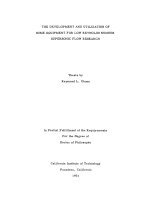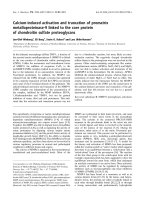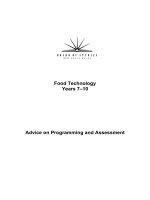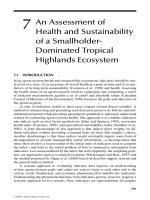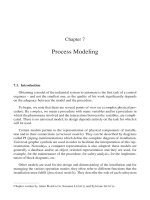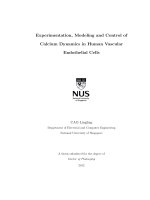Calcium chloride, chitosan and low temperature storage (7 ̊C) effect on biochemical, PLW and marketability of Strawberry cv. Camarosa
Bạn đang xem bản rút gọn của tài liệu. Xem và tải ngay bản đầy đủ của tài liệu tại đây (315.75 KB, 10 trang )
Int.J.Curr.Microbiol.App.Sci (2020) 9(5): 2936-2945
International Journal of Current Microbiology and Applied Sciences
ISSN: 2319-7706 Volume 9 Number 5 (2020)
Journal homepage:
Original Research Article
/>
Calcium Chloride, Chitosan and Low Temperature Storage (7 ̊C) Effect on
Biochemical, PLW and Marketability of Strawberry cv. Camarosa
Ashwini Kumar1, Kumari Karuna1*, Feza Ahmad1, Abhay Mankar2 and Ankita Sinha3
1
Department of Horticulture (Fruit & Fruit Tech.), 2Directorate of Extension Education,
3
Department of Plant Breeding and Genetics, Bihar Agricultural College,
Sabour, Bihar, India
*Corresponding author
ABSTRACT
Keywords
Strawberry,
Chitosan, Calcium
Chloride, T.S.S.,
Anthocyanins,
PLW, Marketability
Article Info
Accepted:
23 April 2020
Available Online:
10 May 2020
The trial was conducted in the year 2017 to observe the biochemical properties of
strawberry cv. Camarosa by the pre-harvest application of chitosan, calcium
chloride and low temperature storage (7 ̊C) condition. The maximum TSS was
observed in T11 (Chitosan @ 6 g/L + CaCl2 @ 1.00% - 10.93B). The maximum
value of anthocyanin was recorded in T4 (CaCl2 @ 1.50% – 39.45 mg/100g) The
least loss in physiological weight and have good shelf-life was recorded in T12
(Chitosan @ 6 g/L + CaCl2 @ 1.50% - 4.20%). At 7C, the highest value of
marketability percentage was found in T11 (Chitosan @ 6 g/L + CaCl2 @ 1.00% 95.38%) which was at par with T12, T10 T9, T7, T8 and T5. Combined effect of
calcium and chitosan resulted in delaying senescence, increasing shelf-life and
firmness with higher fruit quality.
Introduction
Strawberry (Fragaria x ananassa Duch.) is a
small fruit crop of great nutritional and
medicinal values (Maas et al., 1991) and is
one of the most popular fruits among berries
worldwide. The strawberry plant is
herbaceous, perennial and having shallow
root system, comes to flowering after about
four months. Among the fruits, it gives the
quickest return in the shortest time of
plantation and is becoming popular in plain
areas also as a fruit crop. The cultivated
strawberry is suitable for growing under
different agro-climatic condition including
sub-tropical regions.
Strawberries are extremely perishable and
have a very short shelf-life and senescence
period due to their susceptibility to
mechanical
injury,
texture
softening,
physiological disorders and infections caused
by several micro-organisms. The ripe red fruit
of strawberry is interestingly thirst quenching
and juicy. However, after harvesting its shelflife is very short under ambient temperature
2936
Int.J.Curr.Microbiol.App.Sci (2020) 9(5): 2936-2945
due to its thin skin and soft texture when ripe.
This results in the loss of water and a high
risk to infections from disease.
Chitosan is a linear amino polysaccharide
consisting
of
glucosamine
and
Nacetylglucosamine units, which can be
extracted from the exoskeleton of crustaceans,
such as shrimps, crab and pinfish. The use of
chitosan has been approved by the
Environment Protection Agency (EPA) for
fruits and vegetables. Chitosan appears to
play a dual keen function, first by interfering
directly with fungal growth and also by
activating several biological processes in
plant tissues. In addition, due to its polymeric
nature chitosan can form films permeable to
gases. Hence, chitosan has the potential as an
edible antifungal coating material for the
post-harvest produce and delay senescence.
Growers need to produce high-quality fruit
that has the maximum possible storage or
shelf-life to be competitive in the market
place. Application of calcium is related to the
firmness of the fruit by increasing the strength
of call wall, which in turn improves shelf-life
(Van-Buren, 1979). Calcium is one of the
major mineral element determining the fruit
quality which has multiple roles associated
with the plant cells. Pre-harvest Ca treatments
used to increase Ca content of the cell wall
were effective in delaying senescence,
resulting in firmer and enhance fruit quality
(Serrano et al., 2004; Kluter et al., 2006 and
Raese and Drake, 2006). Foliar Ca applied to
strawberries has been shown to delay fruit
harvest, decrease incidence of fruit rot and
improve fruit firmness (Cheour et al., 1990;
Singh et al., 2007; Wojcik and Lewandowski,
2003).
After harvest, refrigeration is most commonly
used to slow decay in strawberries and
maintain quality (El Ghaouth et al., 1991;
Maas, 1980; Nunes et al., 2002). Various
numerous preservation methods have been
used to extend the shelf life and enhance the
quality of strawberry fruits, such as freezing
(Marina et al., 2015), heat treatment (Vicente
et al., 2005), controlled atmospheres (Harker
et al., 2000), gamma irradiation (Peerzada et
al., 2012) and chemical treatments (Castello
et al., 2010). However, some of these
methods have adverse effects on flavour,
taste, color and texture resulting in decline of
the consumer acceptability in the market.
Therefore; the use of natural edible materials
to control physiological processes draws
increasing interest (Pelayo et al., 2003).
Materials and Methods
Experimental site, cultivar and cultivation
In experiment was conducted in the
Department of Horticulture (Fruit and Fruit
Technology), Bihar Agricultural College,
Sabour, Bhagalpur, Bihar. Among the various
cultivars ‘Camarosa’ variety was taken for the
experimental study. The plants were planted
in double row raised bed method in field at a
spacing of 45 cm x 30 cm in field. The beds
were covered with plastic mulch and poly
tunnels imposition was given during the first
week of December to first fortnight of
February to protect the plants from severe
frost.
Spraying of chemicals
The experiment was carried to examine the
effect of foliar application of chitosan and
calcium in combination as well as alone in
nature of application. Varying concentrations
of chitosan (5g/L and 6g/L), calcium chloride
(@ 0.5%, 1.0% and 1.5%) and their
combinations were applied to each treatment.
Chitosan was dissolved in 0.1 N HCl solution
and undissolved substances and impurities
were filtered. Calcium chloride was taken as a
source of Calcium which was dissolved into
2937
Int.J.Curr.Microbiol.App.Sci (2020) 9(5): 2936-2945
water to make solution. The chemicals were
sprayed until the uniform deposition of
solution on the plants especially the fruits
surface. Plants sprayed with the water were
taken as a control treatment in each
replication. The experiment was done to
observe the effects of treatments on storage
and the quality of strawberry fruits. The foliar
application of chemicals was made 10 days
prior to harvesting. After harvesting of the
uniform standard size ripen fruits were taken
for biochemical analysis and storage
condition at 7 ̊C.
Location and climate
Bihar Agricultural College, Sabour is situated
between 25o15’40” North longitude 87 °2’55”
East Latitude with an elevation of 45.72
meters above the mean sea level in the heart
of the vast alluvial Gangetic plains of North
India, South of River Ganga. The climate of
Sabour is semi-arid, subtropical with hot
desiccating summer, cold but frost less winter
with an average annual rainfall of about 1150
mm precipitating mainly in between middle
of June to middle of October. The overall
distribution regarding various details of
meteorological observations was recorded on
monthly basis for maximum and minimum
temperature, rainfall, relative humidity and
wind velocity from December, 2017 to April,
2018 and were collected from agrometeorological
observatory,
Bihar
Agricultural College, Sabour, Bhagalpur have
been presented in Table- 1.
determined during post harvest storage; fruits
were weighed at different sampling intervals.
Then weight loss was calculated by using the
following formula.
PLW (%) = Initial weight – final weight
/Initial weight X 100.
Total Soluble Solids
Total soluble solids in Brix was recorded
with the help of digital refractometer. Fully
ripe fruits of each treatment were taken and
few (2-3) drops of juice from 5 fruits was
taken separately and dropped in the clean
glass on the prism base of the refractometer.
Then pressed ‘ON’ button and took the
reading displayed on the screen of digital
refractrometer. The mean of TSS of the taken
fruits were taken as TSS of the respective
treatments.
Anthocyanin
Aliquots (5.00 g) of the homogenized
strawberry samples were dissolved in 25 ml
methanolic hydrochloric acid (85:15)
solution. The samples were kept for 24 hours
at cool temperature (4-5C) for the extraction
of anthocyanin pigment. The flocculate was
filtered off by a Whattman paper 1 and the
absorbance of the resulting clear liquid was
recorded at 535nm in Spectrophotometer
(Model: Systronics 118). Anthocyanin content
was calculated by using the following formula
Anthocyanin (mg/100g pulp) =
Physiological loss in weight
The initial weight of fruits under each
treatment was recorded replication wise at the
time of storage. The weight of the same fruits
under each treatment was recorded at 3 days
interval and difference in weight was
recorded. The cumulative weight loss was
calculated in per cent on the basis of initial
fruit weight. The weight loss of fruit was
OD (abs 535Å) × volume of solution × 100
------------------------------------------------X 100
Weight of sample × 98.2
Marketability
Healthy and marketable fruits were separated
treatment wise under replication on the day of
observation and percentage of marketable
2938
Int.J.Curr.Microbiol.App.Sci (2020) 9(5): 2936-2945
fruits was calculated on the basis of initial
weight of fruits. Marketability of fruit was
determined on the basis of firmness, colour
and appearance of fruits.
Market ability (%) = 100 – spoiled fruit (%).
Statistical analysis
A randomized complete block design with 12
treatments and three replications were used in
this study. Ten fruiting plants were used as an
experimental unit. Data were subjected to
analysis of variance. Arcsine transformation
was applied on percentage data. The analysis
of data was done in DMRT form. Post-harvest
analysis was done at 3 days interval at low
temperature storage condition at
7 ̊C. The
application of calcium chloride, chitosan and
their combinations was made at pre-harvest
level.
Results and Discussion
Physiological loss in weight
The soft nature of strawberry fruit makes it
extremely perishable, which results that it
hardly remains fresh at room temperature for
around 2 days. Low temperature storage (at 7 ̊
C) has helped to reduce the PLW as well as
the pre-harvest spraying of chemicals also
have positive effect which can be noted from
the treated fruits and the control one.
With the reference from the data reported in
table 2 demonstrate that treatment chitosan @
6g/L + CaCl2 @ 1.5% treated to be the
superior one in reducing the physiological
loss in weight (T12 – 4.20 %) as compared to
the control (T1 – 7.69 %). The loss in fruit
weight was mainly due to evaporation and
transpiration loss of water; and somewhere
dry matter lost by respiration. Chitosan
coatings act as barriers, thereby restricting
water transfer and protecting fruit skin from
mechanical injuries, as well as sealing small
wounds and thus delaying dehydration
(Ribeiro et al., 2007). Chitosan coating has
been reported as an effective material in
controlling
water
loss
from
other
commodities. Calcium helps to maintain the
turgidity of the cell and enhance the cell wall
composition maintaining more firmness time.
Serrano et al., (2004), Hafez and Haggag
(2007) and Mahmoud (2008) had realized that
the loss in fruit weight during storage of
sapotas, peaches and nectarines, apples and
peaches, respectively was greatly reduced due
to pre-harvest sprays of calcium in the form
of calcium chloride at 0.3-7.5%.
Total soluble solids
The loss of texture is one of the main factor
which limits quality and post-harvest shelflife (Figuerire et al., 2012). Table 3 shows
that the TSS was changed over the storage
period. On the 4th day of low temperature
storage, we could observe a slight increase in
the TSS of all the treatments which ranged
from T1 – 8.62B to T11 – 11.25B. However,
on the 7th day, deteriorating changes and
decline in TSS was recorded in each
treatment. Nevertheless, considering that an
acceptable strawberry flavor is achieved with
a minimum TSS of 7 % (Manning, 1996);
they were not of the best quality for
consumption.
Pre-harvest spraying of calcium and chitosan
results to the activation of number of enzymes
which might have been stimulated the
physiological processes in terms of
hydrolyzed starch and polysaccharides.
Metabolic activity during the change of
available starch, organic acid into soluble
sugars and enhanced solubility of insoluble
starch and protein present in the cell wall and
middle lamella, thus TSS might have been
increased. Qureshi et al., (2013) on
strawberry found similar results with respect
to TSS.
2939
Int.J.Curr.Microbiol.App.Sci (2020) 9(5): 2936-2945
Anthocyanin content
According to the literature, the biosynthesis
pathway for anthocyanin is still operative
after strawberry harvest and storage at low
temperatures does not inhibit this process
(Holkroft and Kader, 1999; Kalt and
Macdonald, 1996). The amount of
anthocyanin is important for the maturity
determination and attractiveness. With
reference from the data obtained from table 4
low temperature not only lowered the rate of
pigment synthesis but also the ultimate level
of anthocyanin. Pelargonidin and cyanidin
glycosides are the principle pigments found in
the strawberry.
Fruits produced by the plants sprayed with
chitosan and calcium chloride exhibited the
highest total anthocyanin (T4 – 39.45
mg/100gm pulp) content with statistically
significant difference from the total
anthocyanin content from the control (T1 –
37.21 mg/100gm pulp) plants. Calcium
treatment has been found to increase colour
formation of strawberry fruits by affecting
phenylalanine ammonia lyase and tyrosine
ammonia lyase activities, thus justifying
partly the more anthocyanin content of the
fruits deriving from the plants treated with
calcium. Similarly, chitosan treated fruits
might have stimulated the metabolic activity.
It could also be the effect of higher sink
strength and/or assimilate supply, thus
providing more substrate for anthocyanin
formations. Saavedra et al., (2016) and Xu et
al., (2014) found similar results with respect
to anthocyanin on strawberry.
Table.1 Weather condition prevailing during experiment period (December 2017 to April 2018)
Date
02 Dec. – 08 Dec.
09 Dec. – 15 Dec.
16 Dec. – 21 Dec.
23 Dec. – 31 Dec.
01 Jan. – 07 Jan.
08 Jan. – 14 Jan.
15 Jan. – 21 Jan.
22 Jan. – 28 Jan.
29 Jan. – 04 Feb.
05 Feb. – 11 Feb.
12 Feb. – 18 Feb.
19 Feb. – 25 Feb.
26 Feb. – 04 Mar.
05 Mar.-11 Mar.
12 Mar.-18 Mar.
19 Mar.-25 Mar.
26 Mar.-01 Apr.
02 Apr.-08 Apr.
Temperature (oC)
Max.
Min.
23.0
11.7
18.7
8.0
23.3
8.2
23.0
10.0
20.9
8.6
21.3
8.0
22.7
6.0
25.1
8.2
22.2
8.0
25.8
7.9
26.6
9.5
28.4
11.5
29.2
10.5
28.9
12.9
28.4
11.9
30.3
16.4
31.5
21.5
32.9
21.7
2940
Relative Humidity (%)
07.00 A.M.
02.00 P.M.
96.0
72.0
97.0
75.0
95.0
59.0
96.0
74.0
98.0
76.0
96.0
61.0
93.0
48.0
91.0
59.0
98.0
63.0
89.0
51.0
95.0
46.0
86.0
44.0
83.0
36.0
84.5
53.2
83
49.5
87.5
56.1
94.2
67.4
92.5
64.2
Rainfall
(mm)
00.0
00.0
00.0
00.0
00.0
00.0
00.0
12.4
00.0
00.0
00.0
00.0
00.0
3.2
0.6
5.9
0
0
Int.J.Curr.Microbiol.App.Sci (2020) 9(5): 2936-2945
Table.2 Effect of pre-harvest application of calcium chloride and chitosan on PLW in storage
condition at 7 ̊ C
Treatments
1st day
4th day
a
7th day
13.20
Pooled
a
7.69 a
Control
0.00
9.88
0.50% CaCl2
0.00
7.56 b
10.45 b
6.00 b
1.00% CaCl2
0.00
7.31 c
10.00 c
5.77 c
1.50% CaCl2
0.00
6.99 d
9.27 d
5.42 d
Chitosan 5 g/L
0.00
7.05 d
8.73 e
5.26 e
Chitosan 5 g/L + 0.50% CaCl2
0.00
6.70 e
8.65 e
5.12 f
Chitosan 5 g/L + 1.00% CaCl2
0.00
6.23 f
8.41 f
4.88 g
Chitosan 5 g/L + 1.50% CaCl2
0.00
6.07 g
8.08 g
4.71 h
Chitosan 6 g/L
0.00
6.58 e
8.17 g
4.91 g
Chitosan 6 g/L + 0.50% CaCl2
0.00
6.11 fg
7.75 h
4.62 i
Chitosan 6 g/L + 1.00% CaCl2
0.00
5.53 h
7.58 i
4.37 j
Chitosan 6 g/L + 1.50% CaCl2
0.00
5.21 i
7.39 j
4.20 k
C.D.(p=0.05)
0.00
0.141
0.142
0.063
Table.3 Effect of pre-harvest application of calcium chloride and chitosan on TSS in storage
condition at 7 ̊ C
Treatments
1st day
4th day
7th day
Pooled
Control
8.11 d
8.62 c
8.14 c
8.29 f
0.50% CaCl2
9.45 c
10.23 b
9.99 b
9.89 e
1.00% CaCl2
10.21 ab
10.93 ab
10.62 ab
10.59 ab
1.50% CaCl2
10.22 ab
10.25 b
10.04 ab
10.17 cde
Chitosan 5 g/L
10.21 ab
10.45 b
10.32 ab
10.33 bcd
Chitosan 5 g/L + 0.50% CaCl2
9.88 bc
10.30 b
10.01 ab
10.06 de
Chitosan 5 g/L + 1.00% CaCl2
10.38 ab
10.67 ab
10.32 ab
10.46 bc
Chitosan 5 g/L + 1.50% CaCl2
10.35 ab
10.60 ab
10.35 ab
10.43 bcd
Chitosan 6 g/L
10.48 ab
10.65 ab
10.12 ab
10.41 bcd
Chitosan 6 g/L + 0.50% CaCl2
10.44 ab
10.67 ab
10.03 ab
10.38 bcd
Chitosan 6 g/L + 1.00% CaCl2
10.88 a
11.25 a
10.66 a
10.93 a
Chitosan 6 g/L + 1.50% CaCl2
10.49 ab
10.84 ab
10.25 ab
10.53 bc
0.717
0.730
0.665
0.381
C.D.(p=0.05)
2941
Int.J.Curr.Microbiol.App.Sci (2020) 9(5): 2936-2945
Table.4 Effect of pre-harvest application of calcium chloride and chitosan on anthocyanin in
storage condition at 7 ̊ C
Treatments
1st day
4th day
7th day
Pooled
Control
37.123
38.07 e
36.43
37.21 e
0.50% CaCl2
38.623
39.39 bcde
37.39
38.47 bcd
1.00% CaCl2
39.190
40.16 abcd
37.55
38.96 abc
1.50% CaCl2
39.653
40.99 a
37.73
39.45 a
Chitosan 5 g/L
38.323
38.91 de
36.33
37.85 de
Chitosan 5 g/L + 0.50% CaCl2
38.810
39.79 abcd
37.44
38.68 abcd
Chitosan 5 g/L + 1.00% CaCl2
39.483
40.37 abc
37.44
39.10 ab
Chitosan 5 g/L + 1.50% CaCl2
39.663
40.62 ab
37.50
39.26 ab
Chitosan 6 g/L
38.457
39.09 cde
36.69
38.08 cde
Chitosan 6 g/L + 0.50% CaCl2
38.867
39.85 abcd
36.97
38.56 abcd
Chitosan 6 g/L + 1.00% CaCl2
39.327
40.23 abcd
37.10
38.88 abc
Chitosan 6 g/L + 1.50% CaCl2
39.423
40.48 abc
37.43
39.11 ab
-
1.415
-
0.907
C.D.(p=0.05)
Table.5(a) Effect of pre-harvest application of calcium chloride and chitosan on marketability in
storage condition at 7 ̊ C
Treatments
1st day
4th day
7th day
Pooled
Control
100.00
81.98 e
65.98 d
82.65 e
0.50% CaCl2
100.00
89.58 d
78.42 c
89.33 d
1.00% CaCl2
100.00
92.67 c
80.46 bc
91.04 c
1.50% CaCl2
100.00
92.67 c
80.92 bc
91.19 c
Chitosan 5 g/L
100.00
100.00 a
83.64 ab
94.54 a
Chitosan 5 g/L + 0.50% CaCl2
100.00
94.61 b
83.89 ab
92.83 b
Chitosan 5 g/L + 1.00% CaCl2
100.00
100.00 a
83.94 ab
94.64 a
Chitosan 5 g/L + 1.50% CaCl2
100.00
100.00 a
83.67 ab
94.55 a
Chitosan 6 g/L
100.00
100.00 a
84.88 ab
94.96 a
Chitosan 6 g/L + 0.50% CaCl2
100.00
100.00 a
85.57 a
95.19 a
Chitosan 6 g/L + 1.00% CaCl2
100.00
100.00 a
86.15 a
95.38 a
Chitosan 6 g/L + 1.50% CaCl2
100.00
100.00 a
85.98 a
95.32 a
0.00
1.281
4.439
1.442
C.D.(p=0.05)
2942
Int.J.Curr.Microbiol.App.Sci (2020) 9(5): 2936-2945
Table.5(b) Effect of pre-harvest application of calcium chloride and chitosan on marketability in
storage condition at 7 ̊ C
Treatments
Control
0.50% CaCl2
1.00% CaCl2
1.50% CaCl2
Chitosan 5 g/L
Chitosan 5 g/L + 0.50% CaCl2
Chitosan 5 g/L + 1.00% CaCl2
Chitosan 5 g/L + 1.50% CaCl2
Chitosan 6 g/L
Chitosan 6 g/L + 0.50% CaCl2
Chitosan 6 g/L + 1.00% CaCl2
Chitosan 6 g/L + 1.50% CaCl2
C.D.(p=0.05)
1st day
85.94
85.94
85.94
85.94
85.94
85.94
85.94
85.94
85.94
85.94
85.94
85.94
-
4th day
64.90 e
71.17 d
74.31 c
74.30 c
85.94 a
76.63 b
85.94 a
85.94 a
85.94 a
85.94 a
85.94 a
85.94 a
1.278
7th day
54.35 e
62.35 d
63.82 cd
64.11 bcd
66.16 abc
66.36 abc
66.43 abc
66.21 abc
67.15 ab
67.68 a
68.16 a
68.03 a
3.187
Pooled
19.21 d
19.76 cd
20.01 bcd
20.06 bcd
19.87 cd
20.09 bcd
20.35 abc
20.19 bc
20.18 bc
20.56 abc
21.19 a
20.83 ab
0.926
Note: Arcsine transformed data of marketability of strawberry fruits.
Marketability
Strawberry is very delicate and fancy fruit
which cannot tolerate slight mechanical
injuries. Referring to the effect of pre-harvest
application of chemicals and stored condition,
obtained data during post-harvest observation
shows significant difference. At 7C storage
condition, the average marketability over the
period of storage of 7 days range from
82.65% to 95.38%. Data obtained in table
5(a) reveals that the highest value of
marketable fruits were found with application
of chitosan @ 6 g/L + CaCl2 @ 1.00% (T1195.38 %) while the lowest was seen in control
(T1 – 82.65%).
Several studies report that marketability of
fruits is unacceptable below 88%. Chitosan
acts as a barrier which decreased the
respiration rate of fruits and reduced the water
loss. It also helps to escape or provide disease
resistant. Calcium serves as a catalytic metal
which enhance the cell wall composition of
fruit and maintain the firmness for a longer
period and also increase the shelf-life. Wojcik
and Lewandowski (2003) and Singh et al.,
(2009) found similar results with respect to
marketability of strawberry fruits (Table 5b).
In conclusion, the findings of the present
study have shown that, in general, CaCl2 and
chitosan especially as a foliar application
have a positive boom effect on post-harvest
quality and reduced physiological loss in
weight in ‘Camarosa’ cultivar of strawberry.
TSS, anthocyanin and marketability were
relatively higher in treated strawberry fruits.
The results suggest that these chemicals
applications could be used to extend shelf-life
and work as a promising alternative as an
environment friendly compounds. Several
other concentration and new chemicals in
combination with in-focusing organic nature
of fruit may be the ahead light view for
further experimental research.
References
Castello ML, Fito PJ, Chiralt A (2010)
Changes in respiration rate and physical
properties of strawberries due to
osmotic dehydration and storage J.
2943
Int.J.Curr.Microbiol.App.Sci (2020) 9(5): 2936-2945
Food Eng. 97: 64-71.
Cheour F, Willemot C, Arul J, Desjardins Y,
Makhlouf J, Charest PM, Gosselin A
(1990) Foliar application of calcium
chloride delays postharvest ripening of
strawberry. J. Amer. Soc. Hort. Sci.
115:789–792.
El Ghaouth A, Arul J, Ponnampalam R,
Boulet M (1991) Chitosan coating
effect on storability and quality of fresh
strawberries J. Food Sci. 56:1618–1631.
Figueroa CR, Opazo MC, Vera P, Arriagada
O, Diaz , Moya-Leon MA (2012) Effect
of postharvest treatment of calcium and
auxin on cell wall composition and
expression of cell wall-modifying genes
in the chilean strawberry (Fragaria
chiloensis) fruit. Food chemistry
132:2014-2022.
Hafez OM, Haggag KHE (2007) Quality
improvement and storability of apple
cv. Anna by pre harvest Applications of
Boric acid and Calcium Chloride. J.
Agric. and Biol. Sci. 2(3): 176-183.
Harker FR, Redgwell RJ, Hallett IC, Murray
SH, Carter G (2000) Physical and
mechanical changes in strawberry fruit
after high carbondioxide treatments.
Postharvest Biol. Technol. 19: 139-146.
Hokcraft DM, Kader AA (1999) Controlled
atmosphere-induced changes in pH and
organic acid metabolism may affect
colour of stored of stored strawberry
fruit. Postharvest Biology and Tech.
17:19-32.
Kalt W, McDonald JE (1996) Chemical
composition of low-bush blueberry
cultivars. Journal of the American
Society for Horticultural Society
121:142-146.
Kluter RA, DT Nattress, Dunne CP, Popper
RD (2006) Shelf life Evaluation of
Bartlett Pears in Retort Pouches.
Journal of Food Science (6): 12971302.
Maas J. (1980) Postharvest diseases of
strawberries, p. 329–353. In: N.F.
Childers
(ed.).
The
strawberry.
Horticultural Pub., Gainesville, Fla.
Maas JL, Wang SY, Galletta GJ (1991)
Evaluation of strawberry cultivars for
allegic acid content. Hort. Science 26:
66-68.
Mahmoud MM (2008) Influence of Gamma
Rays and Some Pre and Post Harvest
Treatments on Behavior of Some Fruits
During Cold Storage. M.Sc. Thesis,
Environmental Sci., Institute of
Environmental Studies and Research.
Ain Shams Univ., Egypt.
Manning K (1996) Soft fruits. In G. B.
Seymour, J. E. Taylor, and G. A.
Tucker (Eds.), Biochemistry of fruit
ripening (pp. 347–377) London:
Chapman and Hall.
Marina S, Leonardo MP, Amelia CR, Roxana
AV (2015) Prefreezing application of
whey protein-based edible coating to
maintain
quality
attributes
of
strawberries. Int. J. Food Sci. Technol.
50: 605-611.
Nunes MCN, Morais AMMB, Brecht JK,
Sargent SA (2002) Fruit maturity and
storage temperature influences response
of
strawberries
to
controlled
atmospheres. J. Amer. Soc. Hort. Sci.
127: 836–842.
Peerzada RH, Mohammad AD, Ali MW
(2012) Effect of edible coating and
gamma irradiation on inhibition of
mould growth and quality retention of
strawberry during refrigerated storage
Int. J. Food Sci. Technol. 47: 23182324.
Pelayo C, Ebeler SE, Kader AA (2003)
Postharvest life and flavor quality of
three strawberry cultivars kept 5 in air
or air + 20 kpa CO2 Postharvest Biol.
Technol. 27: 171-183.
Qureshi KM, Chyghtal S, Qureshi US, Abbasi
NA (2013) Impact of exogenous
application of salt and growth regulators
2944
Int.J.Curr.Microbiol.App.Sci (2020) 9(5): 2936-2945
on growth and yield of strawberry Pak.
J. Bot. 45(4):1179-1185.
Raese JT, Drake SR (2006) Calcium Foliar
Sprays for Control of Alfalfa Greening,
Cork Spot, and Hard End in 'Anjou'
Pears Journal of Plant Nutrition 29(3):
543-552.
Ribeiro C, Vicente AA, Teixeira JA, Miranda
C (2007) Optimization of edible coating
composition to retard strawberry fruit
senescence Postharvest Biol. Technol.
44:63 -70.
Saavedra GM, Figueroa NE, Poblete LA,
Cherian S, Figueroa CR (2016) Effects
of preharvest applications of methyl
jasmonate and chitosan on postharvest
decay, quality and chemical attributes of
Fragaria
chiloensis
fruit
Food
Chemistry 190: 448–453.
Serrano M, Martinez- Romero D, Castillo S,
Guillen F, Valero D (2004) Effect of
preharvest sprays containing calcium,
magnesium and titanium on the quality
of peaches and nectarines at harvest and
during postharvest storage. Journal of
the Science of Food and Agiculture
84(11): 1270-1276.
Singh R, Sharma RR, Moretti CI, Kumar A,
Gupta RK (2009) Foliar application of
calcium
and
boron
influences
physiology disorders, fruit yield and
quality of strawberry (F. x ananassa
Duch.). Acta Horticulturae 84(2): 835838
Singh R, Sharma RR, Tyagi SK (2007)
Preharvest foliar application of calcium
and boron influences physiological
disorders, fruit yield and quality of
strawberry (Fragaria ananassa Duch.)
Sci. Hort. 112:215–220.
Van-Buren JP (1979) The chemistry of
texture in fruits and vegetables J.
Texture Stud 10:1–23.
Vicente AR, Costa ML, Martinez GA, Chaves
AR, Civello PM (2005) Effect of heat
treatments on cell wall degradation and
softening
in
strawberry
fruit.
Postharvest. Biol. Tech., 38: 213-222.
Wojcik P, Lewandowski M (2003) Effect of
calcium and boron sprays on yield and
quality of ‘Elsanta’ strawberry. Journal
of plant nutrition, 26(3):671-682.
Xu W, Peng H, Yang T, Whitaker B, Huang
L, Sun J, Chen P (2014) Effect of
calcium on strawberry fruit flavonoid
pathway
gene
expression
and
anthocyanin
accumulation.
Plant
Physiology and Biochemistry. 289-298.
How to cite this article:
Ashwini Kumar, Kumari Karuna, Feza Ahmad, Abhay Mankar and Ankita Sinha. 2020.
Calcium Chloride, Chitosan and Low Temperature Storage (7 ̊C) Effect on Biochemical, PLW
and Marketability of Strawberry cv. Camarosa. Int.J.Curr.Microbiol.App.Sci. 9(05): 29362945. doi: />
2945
